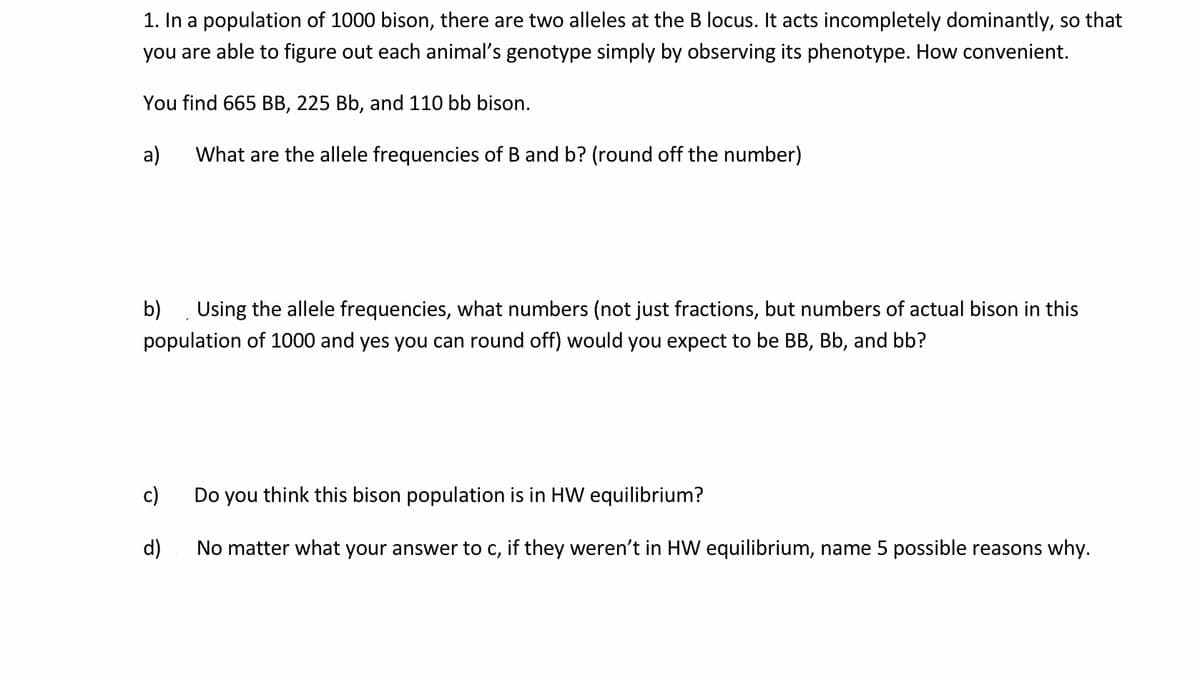1. In a population of 1000 bison, there are two alleles at the B locus. It acts incompletely dominantly, so that you are able to figure out each animal's genotype simply by observing its phenotype. How convenient. You find 665 BB, 225 Bb, and 110 bb bison. a) What are the allele frequencies of B and b? (round off the number) b) Using the allele frequencies, what numbers (not just fractions, but numbers of actual bison in this population of 1000 and yes you can round off) would you expect to be BB, Bb, and bb? Do you think this bison population is in HW equilibrium?
1. In a population of 1000 bison, there are two alleles at the B locus. It acts incompletely dominantly, so that you are able to figure out each animal's genotype simply by observing its phenotype. How convenient. You find 665 BB, 225 Bb, and 110 bb bison. a) What are the allele frequencies of B and b? (round off the number) b) Using the allele frequencies, what numbers (not just fractions, but numbers of actual bison in this population of 1000 and yes you can round off) would you expect to be BB, Bb, and bb? Do you think this bison population is in HW equilibrium?
Biology: The Dynamic Science (MindTap Course List)
4th Edition
ISBN:9781305389892
Author:Peter J. Russell, Paul E. Hertz, Beverly McMillan
Publisher:Peter J. Russell, Paul E. Hertz, Beverly McMillan
Chapter21: Microevolution: Genetic Changes Within Populations
Section: Chapter Questions
Problem 7TYK: A population of mice is at HardyWeinberg equilibrium at a gene locus that controls fur color. The...
Related questions
Topic Video
Question

Transcribed Image Text:1. In a population of 1000 bison, there are two alleles at the B locus. It acts incompletely dominantly, so that
you are able to figure out each animal's genotype simply by observing its phenotype. How convenient.
You find 665 BB, 225 Bb, and 110 bb bison.
a)
What are the allele frequencies of B and b? (round off the number)
b)
Using the allele frequencies, what numbers (not just fractions, but numbers of actual bison in this
population of 1000 and yes you can round off) would you expect to be BB, Bb, and bb?
c)
Do you think this bison population is in HW equilibrium?
d)
No matter what your answer to c, if they weren't in HW equilibrium, name 5 possible reasons why.
Expert Solution
This question has been solved!
Explore an expertly crafted, step-by-step solution for a thorough understanding of key concepts.
This is a popular solution!
Trending now
This is a popular solution!
Step by step
Solved in 2 steps

Knowledge Booster
Learn more about
Need a deep-dive on the concept behind this application? Look no further. Learn more about this topic, biology and related others by exploring similar questions and additional content below.Recommended textbooks for you

Biology: The Dynamic Science (MindTap Course List)
Biology
ISBN:
9781305389892
Author:
Peter J. Russell, Paul E. Hertz, Beverly McMillan
Publisher:
Cengage Learning

Human Heredity: Principles and Issues (MindTap Co…
Biology
ISBN:
9781305251052
Author:
Michael Cummings
Publisher:
Cengage Learning

Biology: The Dynamic Science (MindTap Course List)
Biology
ISBN:
9781305389892
Author:
Peter J. Russell, Paul E. Hertz, Beverly McMillan
Publisher:
Cengage Learning

Human Heredity: Principles and Issues (MindTap Co…
Biology
ISBN:
9781305251052
Author:
Michael Cummings
Publisher:
Cengage Learning